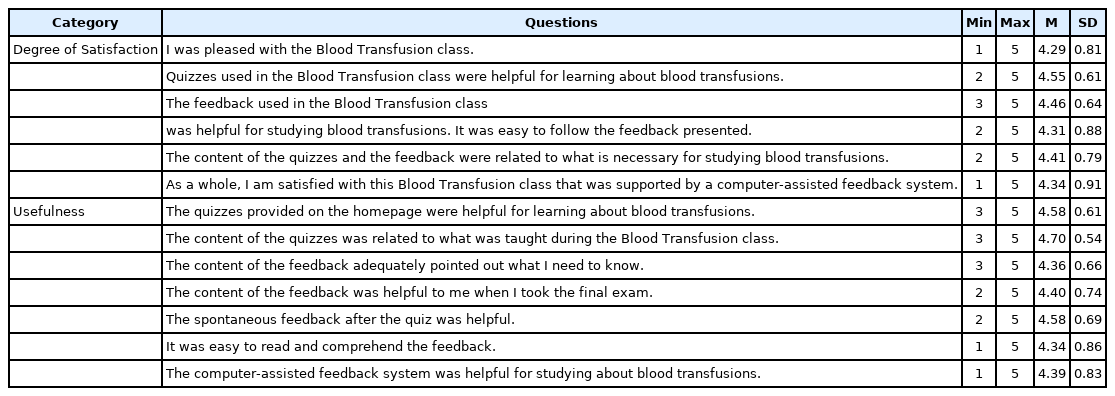A Computer-Assisted, Real-Time Feedback System for Medical Students as a Tool for Web-Based Learning
Article information
Abstract
Abstract
Objectives
Medical students sometimes do not receive proper feedback from their instructors. This study evaluated a newly developed automated and personalized real-time feedback system intended to address this issue.
Methods
Third- and fourth-year medical students participated in quizzes focusing on 17 learning objectives and a five-scale survey that queried their prior knowledge related to blood transfusions. Immediately after completing the quizzes, the students received automated and personalized, real-time feedback and were instructed to take part in self-directed learning. This activity was followed by a final quiz. After completion of the final quiz, the students responded to the five-scale survey that probed the usefulness of and satisfaction with the automated, personalized, real-time feedback system.
Results
Eighty students took part in this study. The third-year group had a higher score for prior knowledge and also on the first quiz (P= 0.008, P= 0.046, respectively). There was no significant difference in final quiz scores between the third- and fourth-year groups (P= 0.633). The scores for usefulness of and satisfaction with the automated, real-time feedback system were 4.45 and 4.34, and 4.55 and 4.40 in the third- and fourth-year students, respectively.
Conclusions
The automated, personalized, real-time feedback system provided timely and effective feedback for medical students and was helpful for their self-directed learning.

The quiz, feedback, and final exam provided to the students in this study. The quiz, feedback, and final exam were hosted on the website, which was developed by the author on the Moodle platform. When students clicked on the quiz question number (A), the quiz question appeared on the screen (B). After completing the quizzes, the students could view feedback that varied depending on quiz score (C), view the activated feedback, and perform self-directed learning guided by the feedback (D). After completion of the self-directed learning, students were permitted to take the final exam.

Subjective opinions from students about the merits and drawbacks of the automated, real-time feedback system. Some highly ranked opinions are listed, and more opinions are included in the “Other” category.

Mean, standard deviation (SD), and t-test results of third- and fourth-year medical students on a survey of prior knowledge, usefulness, and satisfaction conducted using Moodle

